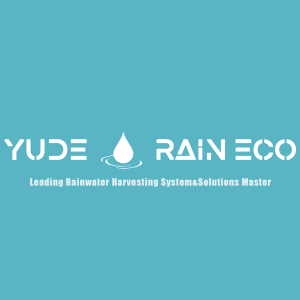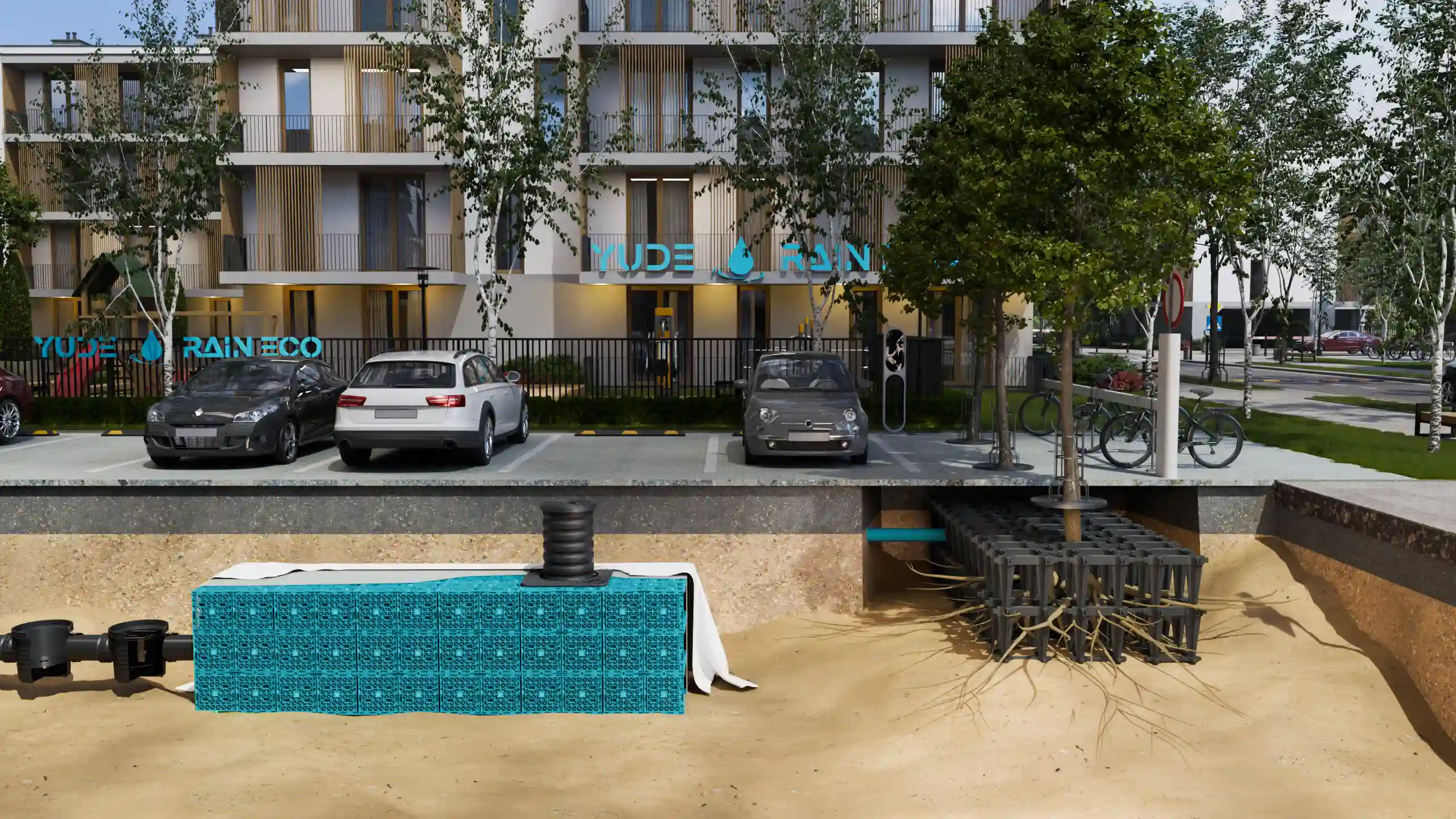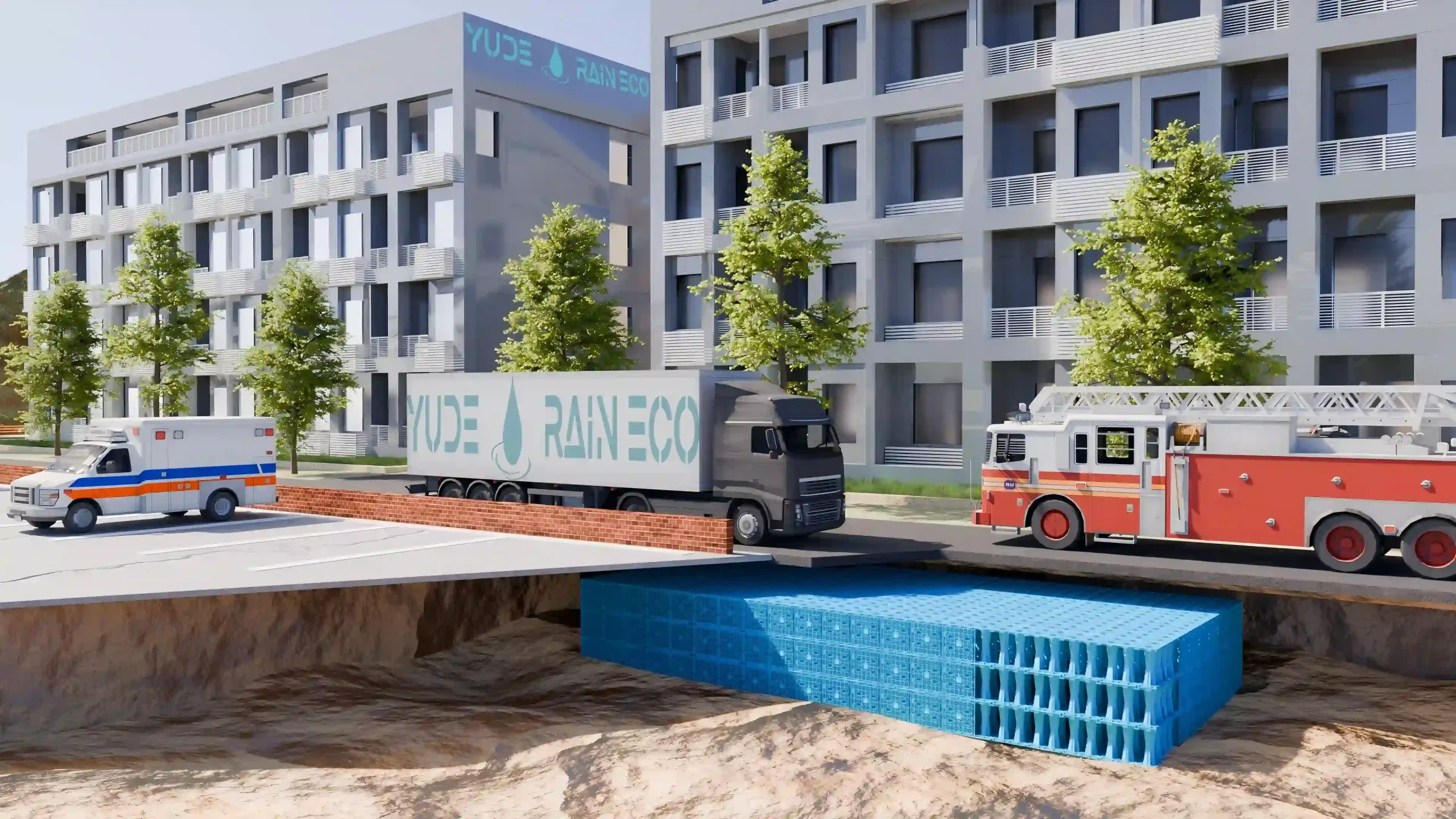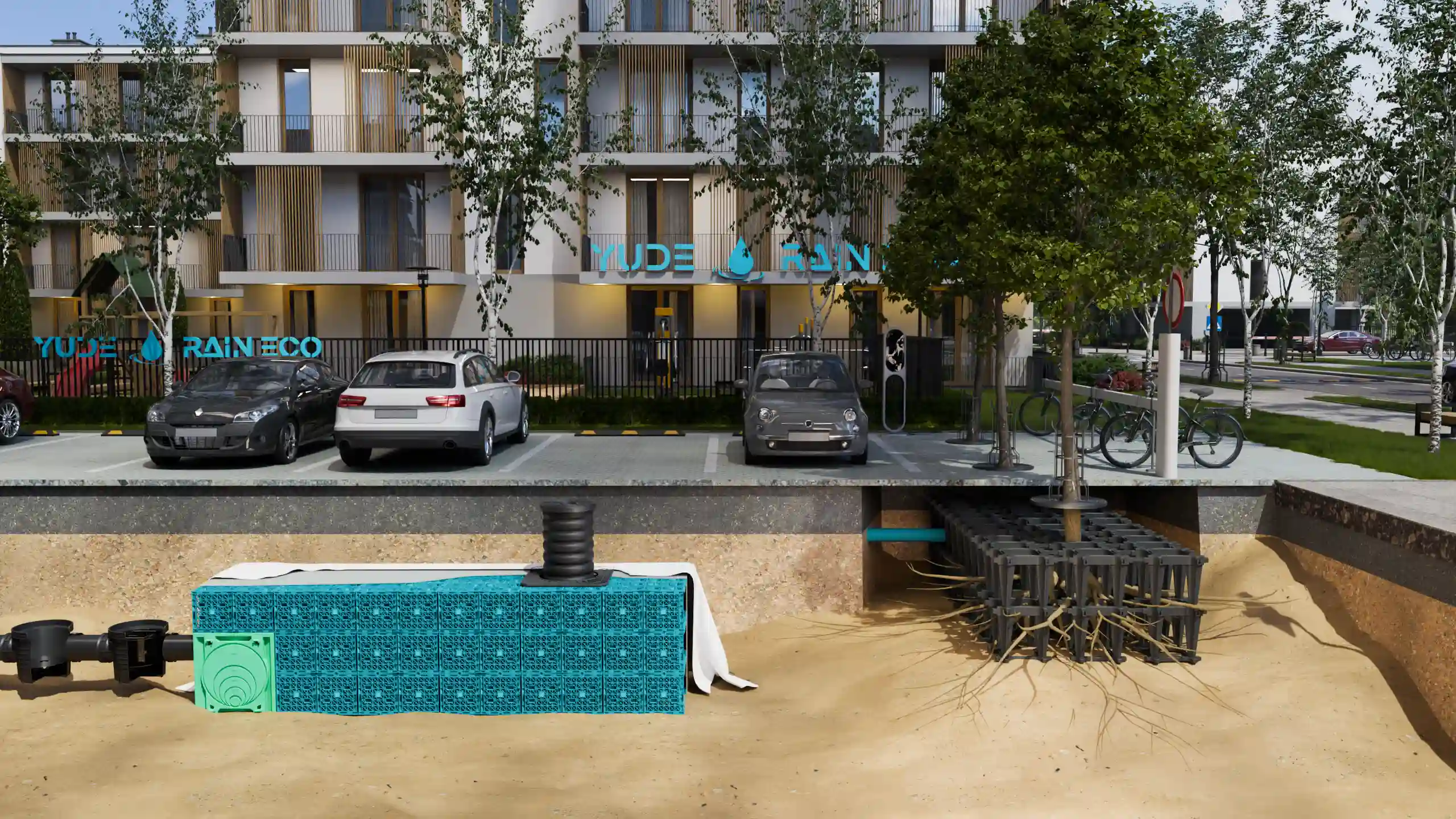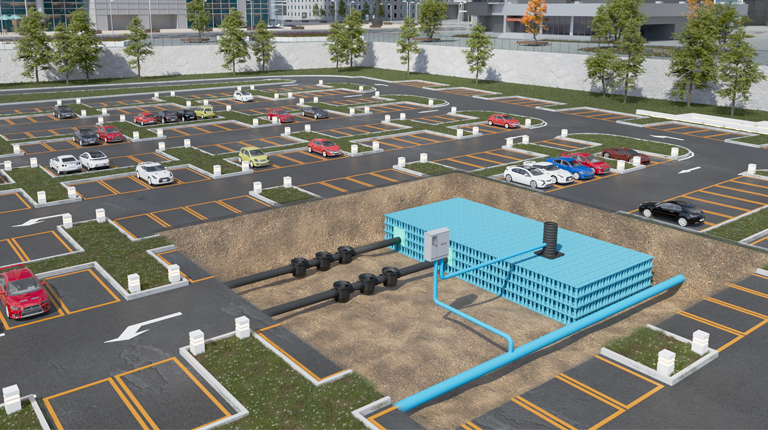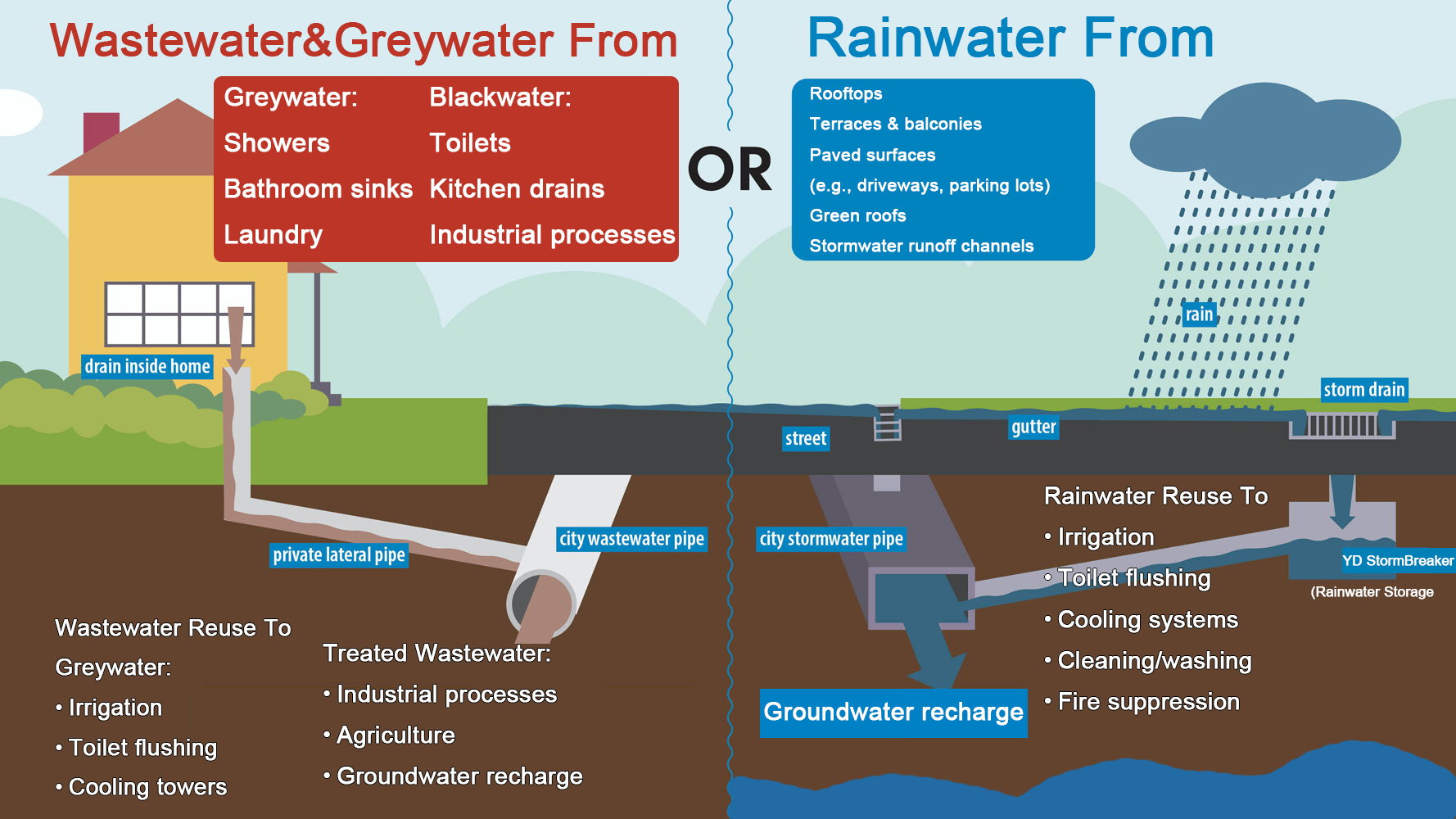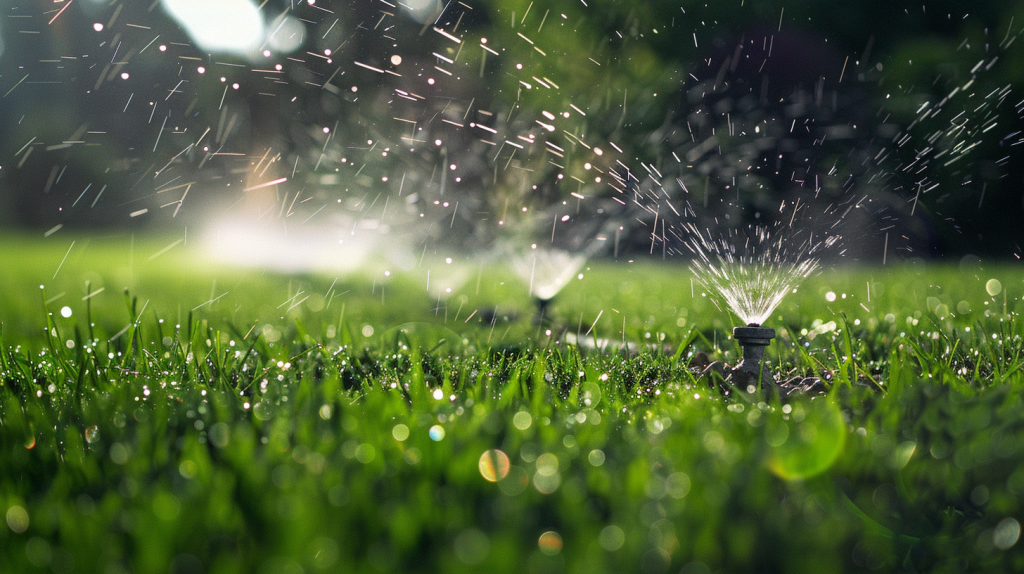Ⅰ. Introduction: Why Urban Drainage Planning Matters More Than Ever
Cities today face a dual challenge: rapid urbanization and the increasing unpredictability of rainfall patterns. With impervious surfaces dominating cityscapes, stormwater runoff overwhelms aging drainage systems, leading to flooding, road damage, and water pollution. Simultaneously, freshwater scarcity continues to intensify, even in non-arid regions.
Municipal authorities are thus compelled to rethink conventional urban water management. Stormwater is no longer a waste stream—it is a resource. By adopting integrated drainage and rainwater harvesting systems, city governments and planners can unlock sustainable solutions that deliver environmental, economic, and social benefits.
This article explores the essential technologies, planning strategies, and system options that help municipalities implement climate-resilient urban greening and water infrastructure while ensuring compliance with environmental standards and community expectations.
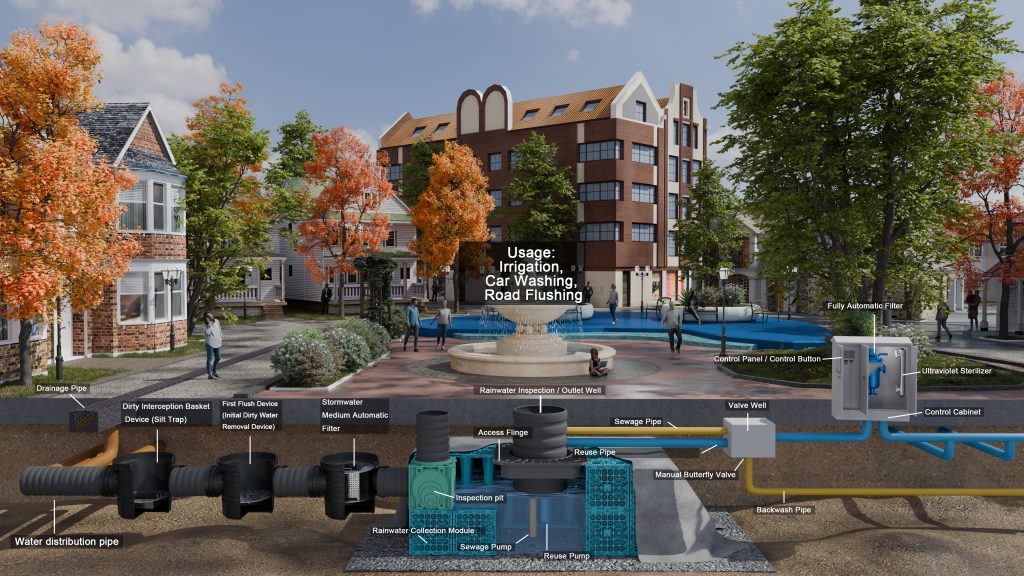
Ⅱ. The Shifting Landscape of Municipal Stormwater Management
Traditional municipal drainage infrastructure typically relied on underground pipes to transport stormwater away from urban areas as quickly as possible. However, this approach:
-
Fails during high-intensity rainfall events
-
Offers no water reuse value
-
Degrades natural hydrology and biodiversity
-
Requires extensive capital investment and rehabilitation costs
In contrast, modern urban drainage design emphasizes:
-
Decentralized detention and infiltration
-
Aboveground greening for evapotranspiration and buffering
-
Reuse systems that supply water for irrigation or public use
-
Smart monitoring and adaptive capacity
This approach is collectively referred to as Sustainable Urban Drainage Systems (SuDS) or Low Impact Development (LID) depending on region.
Ⅲ. Where Do Rainwater Harvesting Systems Fit in Municipal Projects?
Rainwater harvesting systems for municipal applications fall under multiple use cases:
Urban Parks and Greenbelts
Harvested rainwater can be stored and reused for irrigating large green spaces, reducing the need for potable water and maintaining plant health during droughts.
City Roads and Pavement Drainage
Modular attenuation tanks installed under roads or sidewalks store runoff during storms, releasing it gradually to prevent road flooding or sewer surges.
Government Buildings and Schools
Rooftop catchment systems with underground tanks reduce city water bills and act as demonstration projects for environmental education.
Underground Infrastructure Protection
Flood-prone underground utilities (metro stations, tunnels, power hubs) benefit from stormwater buffering tanks that intercept and hold peak volumes.
Public Squares and Landscapes
Integrated rainwater retention beneath open spaces allows for dual use of land, such as plazas with sub-surface drainage crates.
Ⅳ. Long-Term Benefits of Municipal Rainwater Systems
1. Flood Risk Reduction
Attenuation tanks, infiltration systems, and smart flow control valves work together to flatten peak discharge curves, reducing the severity and frequency of urban flash floods.
2. Water Supply Diversification
Non-potable reuse systems reduce demand on municipal freshwater supplies. In parks, stadiums, or public toilets, rainwater can replace 30–70% of potable use.
3. Environmental and Public Health Improvement
By capturing runoff at the source, rainwater systems prevent contaminants from reaching rivers or oceans. This improves water quality and public safety.
4. Infrastructure Cost Optimization
Decentralized systems lower the pressure on central sewer infrastructure, reducing operation and upgrade costs over time.
5. ESG and Public Perception Gains
Cities investing in green and blue infrastructure gain reputation as climate-resilient, environmentally responsible governments—beneficial for grants, public buy-in, and international recognition.
Ⅴ. System Types and When to Use Them
1. Municipal Detention Systems (Stormwater Attenuation)
-
Use: Delay runoff entering sewers
-
Location: Below roads, plazas, parks
-
Structure: Modular crates like YD StormBreaker®, geotextile-wrapped, with flow control chambers
-
Benefit: Low maintenance, highly scalable
2. Urban Infiltration Systems
-
Use: Recharge groundwater and reduce outflow
-
Location: Tree pits, parking lots, bioswales
-
Structure: Sub-surface soakaway crates
-
Benefit: Ideal for permeable soils, eco-integration
3. Green Roof Harvesting and Reuse
-
Use: Capture rooftop water for reuse
-
Location: Government buildings, schools
-
Structure: Filter unit + underground tank + reuse pump
-
Benefit: Reduces rooftop discharge, supports greening
4. Park and Open Space Irrigation Tanks
-
Use: Watering green infrastructure
-
Location: Urban parks, green corridors
-
Structure: Gravity-fed or pump-assisted storage systems
-
Benefit: Cuts utility irrigation costs, supports urban heat mitigation
5. Tree-Friendly Drainage: The YD StormVault® Urban Tree Root System
Urban tree planting is no longer just about aesthetics—it is a core part of modern city climate resilience strategy. However, traditional tree pits often suffer from poor drainage, compaction, and root confinement, resulting in tree mortality, pavement damage, and increased urban heat.
YudeRainEco’s YD StormVault® system provides a scalable, engineered solution that integrates tree root growth support, subsurface stormwater retention, and urban runoff infiltration—all within a compact footprint.
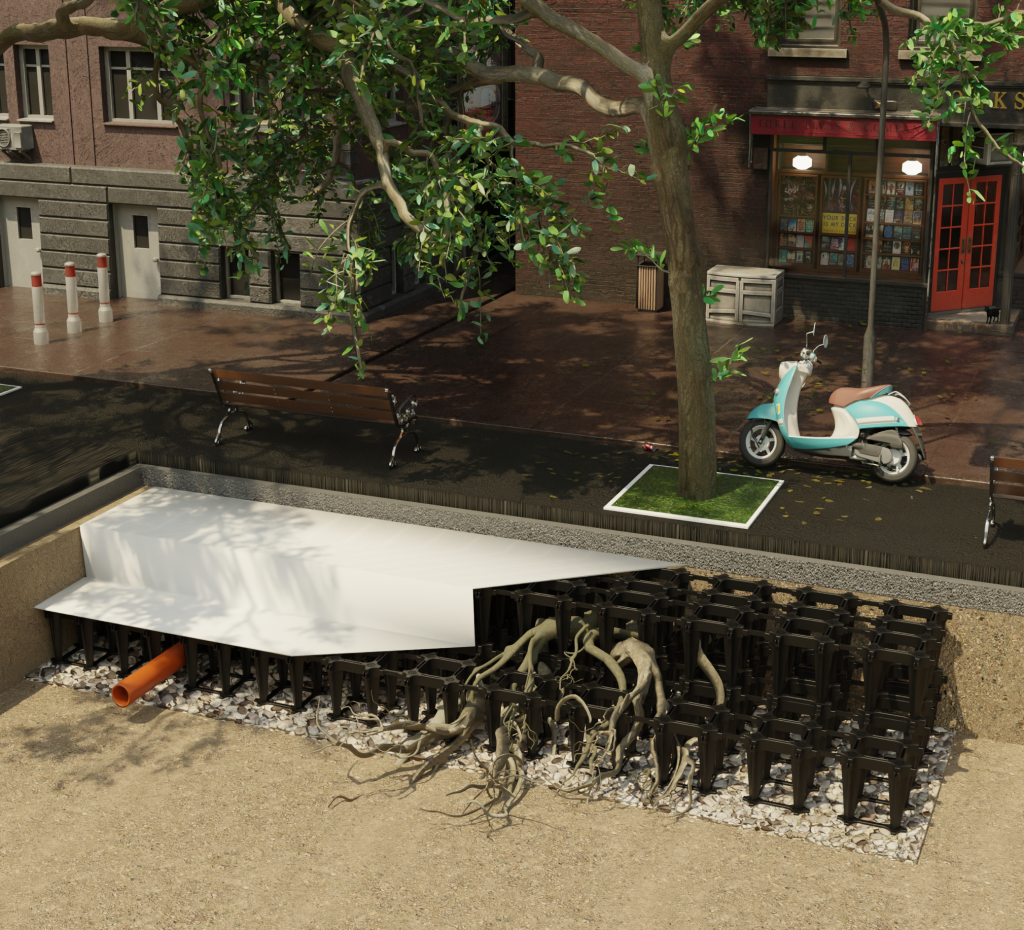
Key Features of YD StormVault® for Urban Tree Infrastructure
1. Root-Friendly Structure
-
Engineered modular crate system maintains stable soil volume for roots
-
Prevents root compaction and allows lateral and vertical root growth
-
Protects adjacent pavement from root uplift
2. Dual-Function Water Management
-
Acts as a subsurface stormwater retention zone
-
Supports gradual infiltration or controlled outflow
-
Helps trees survive droughts with passive irrigation from stored rainwater
3. Load-Bearing Capability
-
Supports pedestrian, light-vehicle, or roadway installations
-
Suitable for sidewalks, medians, public squares, and park edge zones
4. Greening with Drainage Compliance
-
Complies with urban SuDS (Sustainable Drainage Systems) and green infrastructure goals
-
Compatible with bioswales, rain gardens, and other WSUD strategies
Where YD StormVault® is Used
-
Tree-lined streets and boulevards
-
Urban parks and plaza edges
-
Transit corridors with combined greenery and drainage zones
-
Public square retrofits for shade and runoff control
In one Southeast Asian pilot, StormVault® modules were installed under 300 newly planted trees along a redesigned city avenue. After one year:
-
Tree canopy vitality was 2.3x higher vs traditional pits
-
Rainwater runoff to drains was reduced by 45%
-
Root-related sidewalk damage was zero
Benefits for Municipal Planners and Landscape Architects
-
Enhance tree survival rate in comp
-
Meet stormwater regulations without large aboveground detention space
-
Improve pedestrian comfort and urban temperature control
-
Support ESG and climate adaptation metrics in public tenders
YudeRainEco provides full design integration, including:
-
Tree pit layout CAD blocks
-
Soil + crate volume calculations
-
Hydraulic performance modeling
-
Installation supervision and root zone management guides
Ⅵ. Planning Guidelines for Municipal Rainwater and Drainage Projects
Successful public rainwater harvesting infrastructure requires careful hydrological planning and stakeholder alignment.
Key considerations include:
-
Catchment Area Calculations: Size tanks to capture runoff from relevant hardscapes
-
Peak Flow Assessment: Use historical rainfall and future projections to model detention needs
-
Soil Infiltration Rate Testing: Determines if reuse, infiltration, or discharge is appropriate
-
Regulatory Compliance: Align with regional drainage policies (e.g. WSUD, SuDS, LID, EN standards)
-
Integration with Urban Design: Co-locate infrastructure with green spaces, roads, or schools
-
Community Engagement: Communicate public benefit, ensure access and aesthetic integration
YudeRainEco supports municipalities with end-to-end planning assistance including site surveys, CAD layout integration, flow simulation, and compliance documentation.
Ⅶ. Smart Materials and Modular Systems for Modern Cities
YudeRainEco’s modular stormwater systems offer municipalities unparalleled flexibility:
-
YD StormBreaker® modules support loads up to 60 tons, suitable for heavy-traffic roads
-
Lightweight design enables fast, shallow excavation with minimal disruption
-
Geotextile-wrapped void structures allow for both detention and infiltration
-
Modular stacking enables depth variation across slope gradients
-
Recycled PP material aligns with sustainability policies and LEED/BREEAM targets
Ⅷ. Municipal Case Study: Urban Flood Management in Southeast Asia
In 2024, a coastal city in Southeast Asia faced increasing complaints of street-level flooding during monsoon season. YudeRainEco worked with a local government engineering office to install over 3,000 cubic meters of underground attenuation capacity beneath a major intersection and adjacent park.
Key components included:
-
YD StormBreaker® 45T modular crates
-
Overflow routing to a bioswale and wetland zone
-
Inspection tunnels for long-term O&M
-
Smart sensors to monitor water levels and flow
As a result, peak discharge to the municipal drain network dropped by 40%, eliminating surface water pooling during heavy storms. Public satisfaction rose, and city maintenance costs were reduced by over 25% within the first year.
Ⅸ. Common Challenges and How to Overcome Them
Misunderstanding System Purpose
Municipal clients sometimes confuse detention systems with water reuse systems. The two may overlap, but not always. Proper site analysis and functional goals must guide design.
Ignoring Soil Conditions
Choosing infiltration-based systems in clay soils can cause failure. Soil testing must guide infiltration feasibility.
Lack of Maintenance Access
Systems without access ports or inspection tunnels become unserviceable, leading to clogging and odor problems.
YudeRainEco Solution:
We pre-design with maintenance in mind. Every tank includes inspection risers and optional tunnels. All solutions come with long-term O&M manuals and training support for municipal teams.
Ⅹ. How to Integrate Rainwater Harvesting into Urban Landscape and Road Drainage Projects
In modern municipal development, stormwater systems can no longer exist in isolation. Cities are increasingly seeking multi-functional infrastructure that integrates water management with urban livability, ecological restoration, and aesthetic value. Rainwater harvesting systems—when designed thoughtfully—can be embedded into urban green infrastructure to serve both hydraulic and ecological functions.
1. Green Streets and Permeable Corridors
By incorporating underground attenuation tanks beneath tree-lined streets, cities can manage stormwater while supporting healthy tree growth and heat island reduction. These systems allow runoff to be stored temporarily and released or infiltrated beneath bioswales or tree pits.
2. Urban Roadways with Subsurface Drainage Crates
Modular geocellular crates like YD StormBreaker® can be installed beneath major roads, intersections, and bus terminals without affecting the structural integrity of pavement. During storm events, the system captures runoff and gradually releases it, preventing road surface ponding and drainage overload.
3. City Plazas and Public Parks with Dual-Use Storage
Many cities are now designing public spaces with stormwater management zones beneath open spaces, enabling plazas to function both as recreational areas and stormwater buffers. These underground tanks store water for later irrigation, maintaining green cover without tapping potable water sources.
4. Government Buildings and Civic Facilities
Institutional sites like schools, libraries, and municipal halls offer a chance to demonstrate public sustainability leadership. Rooftop rainwater can be collected and used for landscape irrigation or toilet flushing, reducing operating costs and setting a public example.
Key Design Tips for Successful Integration
-
Coordinate early with landscape architects and road engineers to co-locate tank systems with greenspaces, parking, or pavement zones
-
Ensure structural loads and cover depth are assessed for vehicle-bearing applications
-
Include access points for inspection and maintenance to avoid buried system neglect
-
Design overflow pathways in case of extreme rainfall events to prevent surface damage
-
Quantify reuse demand (irrigation, flushing, etc.) to match tank capacity with real need
By embedding rainwater harvesting into visible, valuable public zones, municipalities enhance both climate resilience and citizen engagement, while reducing the cost of operating urban greenspaces. YudeRainEco provides not just products, but planning support, CAD-ready components, and real-world design insight to ensure success.
Ⅺ. Why Choose YudeRainEco
-
One-stop technical partner: From feasibility to system delivery
-
Engineered systems backed by structural certification
-
Global experience with local compliance adaptation
-
Modular solutions tailored for roads, parks, schools, and plazas
-
On-site installation support and post-project maintenance guidance
-
Green procurement compatibility: Recycled material use, low-carbon systems
-
Transparent documentation: Technical drawings, material specs, flow reports
With over 100 municipal-scale projects delivered across Asia and the Middle East, YudeRainEco is trusted by engineers, consultants, and city planning offices seeking scalable, compliant, and maintainable drainage infrastructure.
Ⅻ. Bring Water Resilience Into Your Urban Master Plan
Cities of the future will not rely solely on concrete pipelines and reactive drainage. They will be powered by distributed, intelligent, and ecologically integrated systems that capture water where it falls and use it where it’s needed most.
YudeRainEco offers city governments and municipal contractors the tools to build such a future—modular, proven, and engineered for performance.
Whether your municipality is facing increased rainfall intensity, urban development pressures, or sustainability mandates, we can help turn water from a problem into a long-term asset.
ⅩⅢ. Municipal Procurement: What Decision-Makers Should Look for in Rainwater Infrastructure Partners
When planning large-scale urban infrastructure such as rainwater harvesting and drainage systems, municipal procurement officers and engineering consultants face multiple challenges—from ensuring cost-efficiency to long-term durability and regulatory compliance. Choosing the right technology partner is as important as the system itself.
Here are five factors municipal buyers should prioritize when sourcing stormwater infrastructure providers:
1. Proven Track Record in Public Projects
Does the provider have experience with government tenders and public installations? YudeRainEco has delivered over 100 municipal-scale installations globally, from Southeast Asian smart cities to Middle Eastern industrial townships.
2. Material and Structural Certification
Public projects require compliance with national and international standards (EN, ASTM, ISO). All YudeRainEco modules are structurally tested and compliant with load-bearing up to 60 tons, suitable for installation beneath roads and plazas.
3. System Longevity and O&M Support
The supplier should offer clear documentation, design life expectancy, and maintenance manuals tailored to municipal departments. YudeRainEco’s systems use chemically inert recycled PP that lasts over 50 years with minimal degradation.
4. Budget Efficiency and Scalability
Modular systems allow flexible planning: start small with 200–500m³ detention and expand later. This suits city budgets operating under multi-phase development cycles.
5. After-Sales Support and Technical Training
YudeRainEco offers post-installation training to public maintenance teams and provides remote troubleshooting, flow simulation review, and annual performance inspection services upon request.
ⅩⅣ. Budgeting and Cost Considerations in Municipal Rainwater Projects
One of the most common concerns from public officials and urban planners is cost. However, rainwater harvesting and attenuation systems offer both short-term and long-term cost advantages when evaluated correctly.
CapEx Breakdown
-
Excavation and site prep: 20–25%
-
Modular tank and components: 35–45%
-
Filtration, flow control, pumps: 15–20%
-
Installation labor: 10–15%
-
Inspection manholes and accessories: 5–10%
YudeRainEco’s modular crates can reduce installation time by 40–60% compared to cast-in-place concrete tanks, translating to significant savings in machinery rental and workforce deployment.
Return on Investment
Municipal clients often recover project costs through:
-
Reduced municipal water consumption
-
Deferred investment in sewer expansion
-
Lower maintenance due to decentralized control
-
Green building certification credits and policy incentives
-
Enhanced flood resilience and lower insurance claims
ⅩⅤ. Future Trends in Urban Drainage and Public Water Management
Forward-looking cities are not only addressing current drainage issues—they’re future-proofing their urban water systems. Here are several trends reshaping how municipal projects are being designed:
1. Integration with Smart City Platforms
IoT-based sensors and cloud-connected controllers enable real-time monitoring of water levels, inflow rates, and system integrity. YudeRainEco tanks can be fitted with inspection sensors for smart data logging.
2. Multi-functional Urban Infrastructure
Cities increasingly require infrastructure to serve multiple roles: roads with stormwater detention beneath, parks with groundwater recharge zones, rooftops with solar + rainwater collection.
3. Policy Alignment with Carbon and Biodiversity Goals
Governments now align infrastructure spending with net-zero carbon targets, green urbanism, and urban biodiversity strategies. Rainwater harvesting helps achieve all three.
4. Cross-Sector Collaboration
Urban planners now collaborate with environmental agencies, public health departments, and transport authorities to co-design more resilient and integrated systems.
ⅩⅥ. Frequently Overlooked Opportunities in Municipal Drainage Projects
Even experienced project teams sometimes miss key integration opportunities during planning stages. Here are examples where small changes can yield big returns:
-
School yards and sports fields as temporary detention zones
-
Bus terminals with permeable paving plus modular tanks beneath
-
Tree pits with root-zone infiltration supported by geocellular structures
-
Vacant land parcels turned into bioretention basins before redevelopment
-
Underpass and subway entrance basins with flood mitigation crates
YudeRainEco can assist planners in identifying and modeling these integration points through GIS mapping, runoff analysis, and spatial design coordination.
ⅩⅦ. Frequently Asked Questions (FAQ)
Q1: Is rainwater harvesting really feasible for large municipal areas?
Yes. With modular underground systems like YD StormBreaker®, cities can scale storage capacity from a few hundred to several thousand cubic meters per site. The modular nature allows systems to be integrated under roads, parks, schoolyards, or public squares with minimal surface disruption.
Q2: What’s the difference between rainwater harvesting and stormwater attenuation?
Rainwater harvesting involves collecting and storing rainwater for reuse (e.g. irrigation, toilet flushing), while attenuation systems temporarily store runoff and release it slowly to reduce flood risk. Many YudeRainEco systems combine both functions—reuse during dry periods and controlled release during storms.
Q3: Can these systems handle heavy traffic loads, such as roads and parking lots?
Absolutely. YudeRainEco’s YD StormBreaker® modules are structurally tested for up to 60-ton load-bearing capacity, making them suitable for installation beneath roads, bus terminals, fire lanes, and logistics hubs.
Q4: How long do modular rainwater systems last?
The high-quality recycled polypropylene (PP) used in our systems has a design lifespan of over 50 years. Modules are UV-resistant, chemically stable, and structurally durable under soil and traffic loads.
Q5: What is required for system maintenance?
Maintenance is minimal but essential. Systems should include:
-
Filter checks and cleaning every 6–12 months
-
Sediment inspection via manholes or tunnels
-
Occasional flushing of first-flush or overflow units
YudeRainEco provides O&M guides and offers training for municipal teams.
Q6: Can these systems be installed in areas with high water tables or clay soils?
Yes, with design adjustments. In low-infiltration soils or high groundwater zones, detention-only or reuse systems are recommended instead of infiltration-based models. Our engineers provide soil testing analysis and design adaptations accordingly.
Q7: Are these systems eligible for green infrastructure funding or carbon credits?
In many regions, yes. Systems that reduce potable water use, prevent runoff pollution, or recharge groundwater contribute to ESG goals, LEED/BREEAM points, and may qualify for government grants or climate adaptation funding.
Q8: What support does YudeRainEco offer beyond supplying products?
YudeRainEco offers:
-
Technical consultation
-
CAD and BIM-compatible design files
-
On-site supervision during installation
-
Compliance documentation
-
After-sales inspections and remote troubleshooting
We are a full-scope engineering partner—not just a supplier.
Contact YudeRainEco
Ready to explore rainwater harvesting and attenuation for your next municipal project?
-
Schedule a project consultation
-
Request engineering specs and CAD files
-
On-site assessments available across Asia, MENA, and Europe

